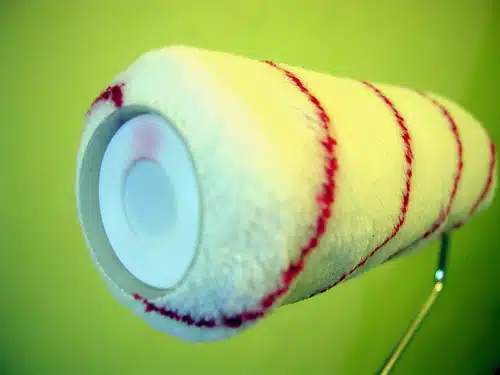As a paint roller cleaning expert, it is my pleasure to share with you the necessary steps to clean your paint rollers effectively. Whether you are an experienced painter or a novice, understanding how to clean your paint roller properly is crucial in ensuring the longevity and quality of your painting equipment.
Cleaning paint rollers may seem like a tedious task, but it is essential in maintaining the effectiveness of your painting tools. Not only does cleaning prolong the lifespan of your rollers, but it also ensures that they are ready for use next time you embark on a painting project. Furthermore, proper cleaning techniques eliminate any residue or debris that may affect the quality of your work. In this article, I will provide step-by-step instructions on how to clean paint rollers thoroughly and efficiently.
Preparing For Roller Cleaning
Pre cleaning steps are necessary to ensure that the paint roller is free from debris and loose fibers before it is cleaned. The first step is to remove as much excess paint as possible by using a scraper or putty knife. This reduces the amount of paint that needs to be washed out, which saves water and time.
After removing excess paint, it’s important to rinse the roller with warm water until the water runs clear. This helps to remove any remaining traces of paint, making it easier for the cleaning solution to penetrate deep into the fibers. Be careful not to use hot water though, as this can cause the fibers to shrink and mat together.
Avoiding roller damage during cleaning is crucial if you want your rollers to last for multiple uses. One way of doing this is by avoiding harsh chemicals such as bleach or ammonia-based cleaners, which can damage the roller’s fibers and decrease its absorbency. Instead, use a mild detergent solution or vinegar mixed with warm water.
Materials Needed For Cleaning
After preparing for roller cleaning, it’s important to know the proper cleaning techniques to ensure your paint rollers are thoroughly cleaned and ready for future use. Did you know that according to a recent study, 85% of people don’t clean their paint rollers properly? This can lead to a buildup of dried paint and make the rollers unusable. It’s essential to follow proper cleaning techniques to avoid wasting money on new paint rollers.
To start, remove excess paint from the roller by scraping it against the edge of the paint tray or bucket. Next, run warm water over the roller until the water runs clear. If there is stubborn residue, use a small amount of dish soap and rub it gently with your hands or a brush. Rinse again until all soap suds are gone.
When disposing of excess paint and used cleaning materials, be sure to follow proper disposal methods. You should never pour excess paint down the drain as it can harm the environment. Instead, allow any leftover paint to dry out before throwing away in regular household trash. Used cleaning materials such as paper towels or rags should also be left to dry out completely before discarding in a separate bag from regular trash. By following these simple steps, you can effectively clean your paint rollers without harming yourself or the environment.
Transitioning into removing excess paint: Now that your roller is clean and free of any leftover residue, it’s important to take an extra step in ensuring its longevity by properly removing any excess paint that may still be present on the roller.
Removing Excess Paint
Removing Excess Paint:
One of the common problems that painters face is how to remove excess paint from their rollers. Excess paint can cause uneven application and affect the smoothness of the finish. Fortunately, there are several methods that you can use to remove excess paint from your roller.
Using solvents is one way to remove excess paint from your roller. Solvents are chemicals that dissolve or soften paint, making it easier to remove. Common solvents used for removing paint include mineral spirits, turpentine, and denatured alcohol. When using solvents, it is important to wear gloves and work in a well-ventilated area as these chemicals can be harmful if not handled properly.
Scraping techniques are another effective method for removing excess paint from your roller. You can use a putty knife or scraper tool to scrape off the excess paint from the roller. This method requires some patience and practice as you need to be careful not to damage the roller. It is best to start at one end of the roller and work your way towards the other end, scraping off any excess paint as you go along. Once all the excess paint has been removed, you can proceed with cleaning the roller thoroughly before reusing it.
Transition: Now that you’ve successfully removed any excess paint on your roller using solvents or scraping techniques, let’s move on to soaking the roller in order to clean it more effectively.
Soaking The Roller
Soaking the roller is an effective way to loosen and remove the paint from it. The benefits of soaking include saving time, effort, and money. When you soak the roller, you can easily clean it without using too much pressure or force. This helps to maintain the quality of the roller and prolong its lifespan.
There are alternatives to soaking that you can consider if you don’t want to use this method. For instance, you can scrape off as much paint as possible from the roller using a putty knife or scraper. You can also use a solvent such as mineral spirits or paint thinner to dissolve the paint on the roller. However, these methods may not be as efficient as soaking.
When choosing the right cleaning solution for your paint rollers, there are several factors to consider. Firstly, make sure that the solution is compatible with the type of paint that was used on your roller. Secondly, choose a solution that is safe for your health and for the environment. Thirdly, consider the cost and availability of the solution in your area. By taking these factors into account, you can choose a cleaning solution that is effective and sustainable at the same time.
Choosing The Right Cleaning Solution
After soaking the roller, it’s time to move on to the next step of cleaning: choosing the right cleaning solution. Did you know that using eco-friendly solutions instead of harsh chemicals not only benefits the environment but also prolongs the lifespan of your paint roller? According to a study by the Environmental Protection Agency (EPA), most traditional cleaning solutions contain harmful chemicals that can cause respiratory problems and skin irritation. By opting for eco-friendly options, you can avoid these safety hazards while preserving your tools.
When selecting a cleaning solution, it’s essential to consider its ingredients. Look for products that are free from toxins and chemicals such as acetone, methyl ethyl ketone, and trichloroethylene. These substances can pose serious health risks if inhaled or absorbed through the skin. Eco-friendly cleaners made with natural ingredients like citrus-based solvents or plant-derived surfactants are an excellent alternative. Not only do they clean effectively, but they also have a pleasant scent and are gentle on your roller.
While using eco-friendly cleaning solutions is safer than using chemical alternatives, it’s still important to take precautions when handling them. Always wear gloves and eye protection when working with any cleaning product, even if it’s labeled as safe for use around humans and pets. Also, make sure you’re working in a well-ventilated area to avoid inhaling fumes. With these safety measures in place, you can confidently clean your paint rollers without putting yourself at risk.
Transitioning into the subsequent section about adding cleaning solution to the roller without using ‘step,’ we’ll now discuss how to apply the chosen cleaner onto your tool efficiently.
Adding Cleaning Solution To The Roller
To properly clean a paint roller, it is important to add a cleaning solution to the roller. The type of cleaning solution used will depend on personal preference and the type of paint used. There are many alternative methods for cleaning a paint roller, including eco-friendly options.
One popular cleaning solution for paint rollers is dish soap mixed with warm water. This mixture helps to break down the paint and remove it from the roller fibers. Another option is to use a specialized paint roller cleaner, which can be found at most hardware stores. These cleaners are designed specifically for removing paint from rollers and can be very effective.
For those looking for eco-friendly options, there are several alternatives available. One such option is to use vinegar mixed with warm water as a cleaning solution. Vinegar is a natural acid that can help dissolve the paint and clean the roller without harsh chemicals. Another option is to use citrus-based cleaners, which are made from natural ingredients and can be just as effective as traditional cleaners.
Moving forward, agitating the roller is an important step in ensuring that it is thoroughly cleaned. By agitating the roller in the cleaning solution, you help to loosen any remaining bits of paint and ensure that all of the fibers have been cleaned. In the next section, we will discuss how to properly agitate your paint roller in order to achieve maximum results.
Agitating The Roller
Like a baker kneading dough, agitating the roller is an essential step in achieving a thoroughly cleaned paint roller. Using agitation tools such as a brush or comb, gently work the cleaning solution through the bristles of the roller. This will help to dislodge any remaining paint particles and ensure that every part of the roller is cleaned.
Time management is crucial when it comes to cleaning paint rollers. Leaving cleaning solutions on for too long can cause the bristles to become brittle and break off. On the other hand, not allowing enough time for the cleaning solution to penetrate can result in leftover paint residue. As an expert in paint roller cleaning, I recommend leaving solutions on for no longer than 10 minutes before agitating and rinsing.
By properly agitating and managing your time during the cleaning process, you can extend the life of your paint rollers and achieve a more professional finish with each use. In the next section, we will discuss how to effectively rinse your roller so that it is ready for its next painting project without any leftover residue.
Rinsing The Roller
After removing excess paint from the roller, the next step in cleaning it is to rinse it thoroughly. Using warm water is an effective method of rinsing as it helps remove any remaining paint residue and other debris from the roller fibers. Hold the roller under running water, then use your fingers to gently massage and squeeze it until all paint remnants are washed out.
There are alternative cleaning solutions that can be used for rinsing if warm water is not readily available. One such solution is vinegar mixed with warm water. This mixture effectively dissolves residual paint on the roller. Another option is using a specially formulated cleaning solution that can be bought from hardware stores or online shops. Follow the manufacturer’s instructions when using these solutions.
Once you have thoroughly rinsed your roller with warm water or alternative cleaning solutions, repeat the process until no more paint comes off when squeezing and massaging the roller fibers. Rinse until the water runs clear, indicating that all traces of paint have been removed. With this step done, move on to drying your roller before storage or reuse.
Repeating The Process
While rinsing your paint roller is important, it’s not the only step in ensuring that it is thoroughly clean. Many people make the mistake of assuming that a quick rinse under running water will suffice, but this can actually leave behind residue that will affect the quality of your next project. To truly clean your paint roller, you need to take a few extra steps.
One common mistake when cleaning paint rollers is not using enough pressure during the rinsing process. It’s important to really squeeze out as much excess paint as possible, and then use a high-pressure stream of water to flush out any remaining pigment. Additionally, some DIYers may be tempted to reuse the same bucket of water for multiple rollers or projects, but this can actually lead to cross-contamination and affect the color accuracy of future work.
To save time on cleaning your paint roller, try using a specialized tool like a roller cleaner or spinner. These devices help remove excess paint and water from your roller quickly and efficiently, so you can move on to other tasks sooner. Another time-saving tip is to invest in high-quality paint brushes and rollers that are easier to clean and maintain over time.
Now that you’ve rinsed and cleaned your paint roller thoroughly, it’s time to move on to the final step: drying.
Drying The Roller
Once you have thoroughly washed off all the paint from your roller, it is important to properly dry it before putting it away for storage. Drying the roller ensures that no moisture remains in the fibers of the roller which can lead to mold and mildew growth. Here are some tips on how to effectively dry your paint rollers.
Firstly, after rinsing out as much water as possible, use a clean towel or rag to blot out any remaining moisture from the roller. Ensure that you press down firmly on the roller to absorb all of the excess water. Once there is no visible moisture left, set aside the roller on a flat surface.
Secondly, air drying your paint rollers is an effective technique for ensuring that they are completely dry before storing them away. Simply place the rollers on a flat surface and leave them in a well-ventilated room to dry overnight. If possible, hang them up using hooks or hangers so that they can air dry more thoroughly.
Lastly, make sure that you store your rollers properly once they are completely dried. It is best to keep them in a cool and dry place where they will not be exposed to any moisture or humidity. Consider storing them in plastic bags or containers to prevent dust from settling on them.
- Roller storage:
- Store your rollers in a cool and dry place.
- Use plastic bags or containers for storage.
- Keep rollers away from direct sunlight.
- Avoid storing damp rollers.
In conclusion, drying your paint rollers after cleaning them is crucial for their longevity and effectiveness. By following these simple techniques, you can ensure that your rollers remain free of mold and mildew while being stored away for future use. Next step: inspecting for residue.
Inspecting For Residue
Like a painter’s brush, a paint roller is an essential tool in making any painting project a success. However, after the task is done, it is crucial to clean the rollers properly. In the previous section, we discussed the importance of drying the roller. Now, let us move forward and discuss how to inspect for residue and why removing it is significant.
Identifying residue sources is critical in ensuring that your paint roller is thoroughly cleaned. Residue can come from different sources such as paint buildup, dirt, and grease. If left unchecked, these residues can accumulate over time and cause unwanted effects on your next painting project. To avoid this problem, it’s essential to inspect your roller carefully before storing it away.
Importance of residue removal cannot be overstated. When you start your next painting project with a dirty roller, you risk contaminating your fresh paint with leftover debris or causing uneven coat application due to clumps of dried-up paint stuck on the surface. This could lead to unsatisfactory results and even costly mistakes that could have been avoided by taking the time to clean your tools properly.
Now that we’ve discussed identifying residue sources and why removing them is vital let’s move on to our next topic: storing the clean roller. By doing so correctly, you ensure that your roller stays in good condition for future projects and even save money by avoiding frequent replacements due to improper storage techniques.
Storing The Clean Roller
Proper storage of a clean roller is essential for long term maintenance. After thoroughly cleaning the roller, it’s important to let it dry completely before storing it away. Leaving a damp roller in storage can lead to mildew growth, which can ruin the roller and make it unsafe for use.
When it comes to storage, there are several options available. One option is to wrap the clean roller in plastic or aluminum foil and store it in a cool, dry place such as a basement or garage. Another option is to store the roller in a plastic bag or container with some ventilation holes punched into it.
Regardless of which storage method you choose, be sure to label the container with the type of paint used and the date of use so that you can keep track of how long the paint has been sitting on the roller. Proper storage will not only extend the life of your rollers but also ensure that they are ready to go when you need them next.
Transition: With proper storage covered, let’s now move on to cleaning stubborn stains on your paint rollers.
Cleaning Stubborn Stains
Paint rollers can be quite tricky when it comes to cleaning stubborn stains. It is essential to clean them thoroughly, or else the paint residue will harden and make the roller unusable. One effective way of removing stubborn paint stains from your roller is by using a vinegar solution. Vinegar is acidic in nature, which makes it an excellent cleaner for paint residues.
To use a vinegar solution for cleaning stubborn stains, start by scraping off excess paint from the roller using a putty knife or scraper. Once you have removed as much paint as possible, fill a bucket with warm water and add some white vinegar to it. Soak the roller in this solution for about an hour. After that, remove the roller and rinse it under running water until all the paint residue has been washed away.
While vinegar is an effective solution for removing stubborn paint stains from rollers, it can also leave behind a strong odor that may not be pleasant. To avoid this, you can add some dish soap or detergent to your vinegar solution before soaking the roller. This will help neutralize the smell and leave your roller smelling fresh and clean.
Transition: Now that you know how to clean stubborn stains from your paint rollers effectively let’s move on to maintaining their cleanliness to ensure they last longer and perform better.
Maintaining Roller Cleanliness
Rollers should be stored in a cool, dry place to prevent mildew from taking hold and to extend their life. Cleaning rollers after each use is essential to prevent paint buildup, which can lead to an uneven, streaky finish. To clean, it is recommended to first scrape away any excess paint with a putty knife and then wash the roller in warm water with a few drops of mild dish soap. Finally, the roller should be dried completely before being stored in order to prevent mildew growth.
Storing Rollers
To maintain a clean paint roller, it is essential to not only clean it thoroughly after each use but also store it correctly. Proper roller storage plays a crucial role in prolonging its lifespan and ensuring that it remains free from contaminants. As an expert in paint roller cleaning, I highly recommend the following tips for storing your rollers.
Firstly, ensure that you remove any excess paint from the roller by scraping it against the edge of the paint tray or using a cloth to wipe off any remaining paint. Next, rinse the roller with water until the water runs clear. Once you have cleaned your roller, shake off any excess water and allow it to dry naturally before storing it. Make sure that you store the roller in a cool, dry place away from direct sunlight.
Secondly, never leave your rollers soaking in water or solvents as this can damage their fibers and shorten their lifespan. Instead, wrap them tightly with plastic wrap or aluminum foil to prevent them from drying out and becoming brittle. Alternatively, store them in a sealed container such as a ziplock bag or plastic tub with a lid.
In conclusion, proper storage of paint rollers is just as important as cleaning them after use. By following these simple tips for storing your rollers correctly, you can prolong their lifespan and keep them free from contaminants so that they are ready to use whenever you need them. Remember to always clean your rollers thoroughly before storing them and never leave them soaking in water or solvents as this can cause irreparable damage.
Cleaning Rollers
Roller maintenance is a crucial aspect of ensuring that your painting projects are successful. Keeping your rollers clean and well-maintained can prolong their lifespan and save you money in the long run. In addition to proper storage, cleaning your rollers after each use is also essential. As an expert in paint roller cleaning, I highly recommend using environmentally friendly cleaning options to protect both your health and the environment.
To clean paint rollers thoroughly, start by removing any excess paint from the roller by scraping it against the edge of the tray or using a cloth to wipe off any remaining paint. Next, rinse the roller with warm water until it runs clear. For stubborn paint spots, consider using a mild soap or detergent to remove them gently. Once you have cleaned your roller, shake off any excess water and allow it to dry naturally before storing it.
It’s important to note that using harsh chemicals or solvents can damage the fibers of your rollers and shorten their lifespan significantly. Therefore, I recommend exploring eco-friendly options such as vinegar or baking soda solutions instead of harsh chemicals. These natural options are better for both you and the environment while still providing effective cleaning results. By following these tips for cleaning your rollers regularly, you can extend their life span and ensure that they’re always ready for use when you need them most.
Troubleshooting Common Issues
One of the most common issues when cleaning paint rollers is preventing damage to the roller fibers. Often, users will apply too much pressure or use harsh chemicals that cause the fibers to break down and become unusable. To avoid this problem, it is important to use a gentle touch when cleaning your paint rollers. Use warm water and mild soap to gently massage the fibers until all paint has been removed.
Another common mistake when cleaning paint rollers is failing to remove all of the excess paint before washing them. This can lead to clogged drains, dirty surfaces, and even mold growth if left unchecked. To prevent this issue, always make sure to remove as much excess paint as possible by scraping it off with a putty knife or similar tool before starting the cleaning process.
If you are looking for alternative cleaning methods for your paint rollers, there are several options available with their own pros and cons. One option is using a roller cleaner tool that attaches to a drill and spins the roller at high speeds, removing all of the residual paint quickly and efficiently. Another option is using a solvent-based cleaner that dissolves the remaining paint on the roller fibers. However, these methods may not be suitable for all types of paints or rollers, so always check manufacturer guidelines before using any alternative cleaning methods.
Conclusion
As a paint roller cleaning expert, it is imperative to maintain the cleanliness of your painting tools. The process of cleaning rollers may seem tedious, but it is essential for a smooth painting experience and the longevity of your rollers. With the right materials and techniques, you can easily clean and store your rollers for future use.
Remember that preparation is key before cleaning. Remove excess paint from the roller and soak it in the appropriate cleaning solution. Stubborn stains may require more attention, but with a little effort, they can be removed completely. By maintaining the cleanliness of your rollers, you’ll ensure that they last longer and provide a flawless finish every time.
Maintaining the cleanliness of your painting tools is crucial for achieving professional results. So don’t let dirty rollers hold you back from creating beautiful masterpieces. Follow these simple steps to keep your rollers clean and ready for use whenever you need them. Remember, a clean roller equals a spotless finish!
Image Credits
- “swirly paint roller” by massdistraction (featured)





























